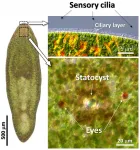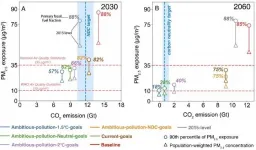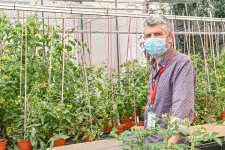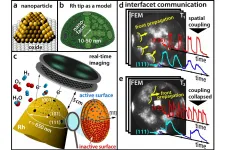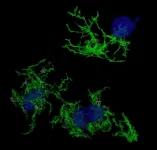In utero exposure to tiny air pollution particles is linked to asthma in preschoolers
Mount Sinai researchers are first to find ultrafine particles from traffic pollution influences asthma risk in US children
2021-05-21
(Press-News.org) New York, NY (May 21, 2021) --Women who were highly exposed to ultra-fine particles in air pollution during their pregnancy were more likely to have children who developed asthma, according to a study published in the American Journal of Respiratory and Critical Care Medicine in May. This is the first time asthma has been linked with prenatal exposure to this type of air pollution, which is named for its tiny size and which is not regulated or routinely monitored in the United States.
Slightly more than 18 percent of the children born to these mothers developed asthma in their preschool years, compared to 7 percent of children overall in the United States identified as having asthma by the Centers for Disease Control and Prevention.
Other types of pollutants are routinely monitored and regulated to reduce potential health effects, such as larger-size particulate pollution and gaseous pollutants such as nitrogen dioxide. These have been associated with asthma risk in children in prior research. This study controlled for exposure to these other types of pollution and exposure to pollutants following birth, and it still found an elevated risk of asthma in children born to mothers with heightened exposure to ultra-fine particles in pregnancy.
Ultra-fine particulate pollution--particles that are smaller than the width of an average human hair--can get deeper into our lungs and pass into our circulation to cause various health effects. Because of this, the researchers said their toxic effects may actually be greater.
"One reason ultra-fine particulates are not routinely monitored is that there have been a number of unique challenges to measuring them accurately. Fortunately, recent methods have been developed to provide such exposure data which allowed us to conduct this study," said lead author Rosalind Wright, MD, MPH, Horace W. Goldsmith Professor in Children's Health Research, Professor of Environmental Medicine and Public Health and Co-director of the Institute for Exposomic Research at the Icahn School of Medicine at Mount Sinai.
This study included 376 mothers and their children, most of them Black or Latinx, who live in the Boston metropolitan area and were already being followed to assess their health. Mount Sinai researchers partnered with a group of scientists at Tufts University in the Boston area who had developed a way to provide valid daily estimations of ultra-fine particulate exposure which could be linked to the area of the mothers' and children's homes. Many of these women were more likely to live near major roadways with higher traffic density where exposure to these tiny particles tends to be higher.
The researchers followed up with the mothers to find out whether the children were diagnosed with asthma. Most of the diagnoses of asthma occurred just after three years of age.
Pollution's effect in utero can alter lung development and respiratory health. This can lead to pediatric disorders like asthma. How this happens is not completely understood but pollution can alter certain bodily regulatory systems like neuroendocrine and immune function that have been linked with asthma in other studies.
While both boys and girls were affected by prenatal ultrafine particle exposure, this study found that girl babies were more sensitive to ultra-fine particle pollution's effects on asthma risk when exposed in late pregnancy. The reason for this phenomenon is also unclear, but studies show it is possibly due to endocrine-disrupting effects of the pollution exposure.
"This research is an important early step in building the evidence base that can lead to better monitoring of exposure to ultrafine particles in the United States and ultimately to regulation. As we advance methods for measuring these tiny particles, we hope for replication of these findings, both within different geographic areas across the United States as well as globally. Childhood asthma remains a global epidemic that is likely to grow with the anticipated rise in particulate air pollution exposures due to effects of climate change," Dr. Wright said.
INFORMATION:
This research was funded by grants from the National Institutes of Health including the Environmental Influences on Child Health Outcomes (ECHO) Program.
About The Institute for Exposomic Research
The Institute for Exposomic Research at the Icahn School of Medicine at Mount Sinai is the world's first research institute devoted to the intensive study of the exposome, or the totality of environmental influences on human health. The mission of the Institute is to understand how the complex mix of nutritional, chemical, and social environments affect health, disease, and development later in life and to translate those findings into new strategies for prevention and treatment. For more information, visit http://icahn.mssm.edu/exposomics.
About the Mount Sinai Health System
The Mount Sinai Health System is New York City's largest academic medical system, encompassing eight hospitals, a leading medical school, and a vast network of ambulatory practices throughout the greater New York region. Mount Sinai is a national and international source of unrivaled education, translational research and discovery, and collaborative clinical leadership ensuring that we deliver the highest quality care--from prevention to treatment of the most serious and complex human diseases. The Health System includes more than 7,200 physicians and features a robust and continually expanding network of multispecialty services, including more than 400 ambulatory practice locations throughout the five boroughs of New York City, Westchester, and Long Island. The Mount Sinai Hospital is ranked No. 14 on U.S. News & World Report's "Honor Roll" of the Top 20 Best Hospitals in the country and the Icahn School of Medicine as one of the Top 20 Best Medical Schools in country. Mount Sinai Health System hospitals are consistently ranked regionally by specialty and our physicians in the top 1% of all physicians nationally by U.S. News & World Report.
For more information, visit https://www.mountsinai.org or find Mount Sinai on Facebook, Twitter and YouTube.
ELSE PRESS RELEASES FROM THIS DATE:
2021-05-21
Scientists from Hokkaido University have discovered a novel defensive response to SARS-CoV-2 that involves the viral pattern recognition receptor RIG-I. Upregulating expression of this protein could strengthen the immune response in COPD patients.
In the 18 months since the first report of COVID-19 and the spread of the pandemic, there has been a large amount of research into understanding it and developing menas to treat it. COVID-19 does not affect all infected individuals equally. Many individuals are asymptomatic; of those who are symptomatic, the large majority have mild symptoms, and only a small number have severe cases. The reasons for this are not fully understood and are an important area of ongoing research.
A team of scientists ...
2021-05-21
The issue of concern was that the Escherichia coli (E. coli) genome, consisting of 4.6 million base pairs of a single circular DNA, is too large to manipulate following the extraction and transfer to other bacteria.
In the present study, a group of Rikkyo University researchers led by Assistant Professor Takahito Mukai and Professor Masayuki Su'etsugu has succeeded in splitting the E.coli genome into tripartite-genome of 1 million base pairs per genome (split-genome) using the smallest E. coli genome strain established so far. In addition, they successfully extracted the split-genome from bacteria and installed it in other E. ...
2021-05-21
All living organisms are equipped with sensory organs to detect changes in their surrounding environment. It may not immediately strike us as obvious but, similar to how we can sense heat, cold, light, and darkness, we are also extremely adept at sensing gravity. In our case, it is our inner ear that does this job, helping us maintain balance, posture, and orientation in space. But, what about other organisms, for instance invertebrates that lack a backbone?
The gravity sensing organ in some aquatic invertebrates, known as a "statocyst," is, in fact, rather fascinating. The statocyst is essentially a fluid-filled sac with sensory cells lining its inner wall and a small, mineralized ...
2021-05-21
[Highlights]
- Integrated cyber attack analysis platform "NIRVANA Kai" newly supports IPv6 and enhances its functions.
- Observation of IPv6 communications, collection of IPv6-related alerts, and real-time visualization of IPv6 networks.
- Expected to simplify security operations in IPv6 networks.
[Abstract]
The Cybersecurity Laboratory of the National Institute of Information and Communications Technology (NICT, President: TOKUDA Hideyuki, Ph.D.) has enhanced its cyber attack integrated analysis platform "NIRVANA Kai" to support the Internet Protocol version ...
2021-05-21
China's clean air policies have substantially reduced PM2.5 air pollution in recent years. Yet >99% of Chinese population is still exposed to PM2.5 concentrations in excess of the World Health Organization (WHO) Air Quality Guidelines of 10 μg/m3. Climate actions targeting to reduce fossil fuel consumption also have substantial air quality benefits. The announcement of ambitious climate commitment to achieve carbon neutrality by 2060 may fuel the power to long-term air quality improvement in China.
Combining Global/China's climate mitigation pathways (i.e. global 2°C- and 1.5°C-pathways, NDC pledges, and carbon neutrality goals) and local clean ...
2021-05-21
An international research group involving the Institute of Molecular and Cellular Biology of Plants (IBMCP), a joint centre of the Universitat Politècnica de València (UPV) and the Spanish National Research Council (CSIC), has discovered that a genetic mechanism, called CHLORAD, which is involved in the ageing of plant leaves, also plays a decisive role in the tomato ripening process. Thus, tomatoes with an activated CHLORAD system turn red more quickly, and accumulate more lycopene, a compound beneficial to health. The results, which have been published in the latest issue of the journal Nature Plants, will lead to better quality tomatoes.
The ripening of most fleshy fruits gives them attractive colours and smells, which is a trick of the plant to spread its seeds ...
2021-05-21
Most of commercial chemicals are produced using catalysts. Usually, these catalysts consist of tiny metal nanoparticles that are placed on an oxidic support. Similar to a cut diamond, whose surface consists of different facets oriented in different directions, a catalytic nanoparticle also possesses crystallographically different facets - and these facets can have different chemical properties.
Until now, these differences have often remained unconsidered in catalysis research because it is very difficult to simultaneously obtain information about the chemical reaction itself and about the surface structure of the catalyst. At TU Wien (Vienna), this has now been achieved by combining different microscopic methods: with ...
2021-05-21
SINGAPORE, 21 May 2021 - Alzheimer's Disease is the most common form of dementia and is characterised by the build-up of amyloid plaques in the brain. Microglia, the immune sentinels of the brain, are not only responsible for eliminating foreign invaders, but also maintaining brain homeostasis by clearing toxic waste such as the amyloid plaques.
However, the role of microglia in Alzheimer's Disease and its relationship to amyloid plaque accumulation remain unclear. Now, a team of scientists from Duke-NUS Medical School and Monash University have found the gene expression signatures underlying microglia associated ...
2021-05-21
More than 100 kg of highly toxic uranium (U) and plutonium (Pu) was dispersed in the form of tiny 'hot' radioactive particles after the British detonated nine atomic bombs in remote areas of South Australia, including Maralinga.
Scientists say that these radioactive particles persist in soils to this day, more than 60 years after the detonations. Previously, we had limited understanding of how Pu was released from these "hot" particles into the environment for uptake by wildlife around Maralinga.
But now, a new study published today in Scientific Reports and led by Monash University researchers warns that the particles are actually more ...
2021-05-21
A new study shows that the current rate of biodiversity decline in freshwater ecosystems outcompetes that at the end-Cretaceous extinction that killed the dinosaurs: damage now being done in decades to centuries may take millions of years to undo.
The current biodiversity crisis, often called the 6th mass extinction, is one of the critical challenges we face in the 21st century. Numerous species are threatened with extinction, mostly as a direct or indirect consequence of human impact. Habitat destruction, climate change, overexploitation, pollution and invasive species are among the main causes for Earth's biota to decline rapidly.
To investigate the tempo of extinction and predict recovery times, an international team of evolutionary biologists, paleontologists, geologists and modelers ...
LAST 30 PRESS RELEASES:
[Press-News.org] In utero exposure to tiny air pollution particles is linked to asthma in preschoolers
Mount Sinai researchers are first to find ultrafine particles from traffic pollution influences asthma risk in US children


